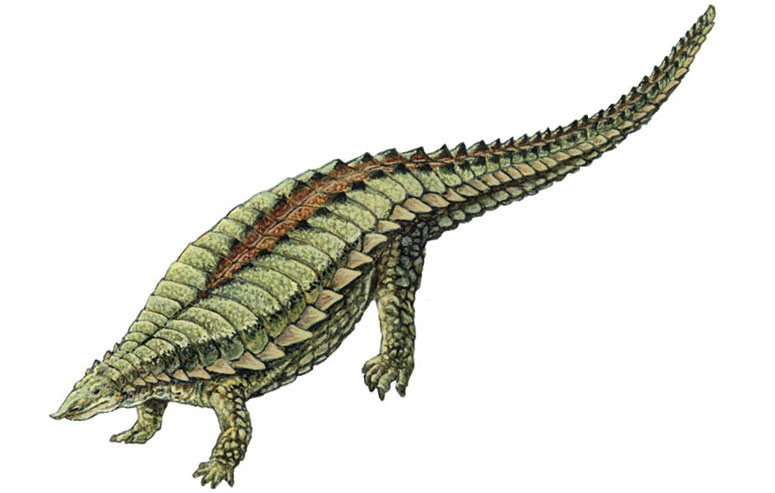[Recent Entries][Archive][Friends][User Info]
| February 29th, 2012 | |
|---|---|
| 08:20 pm [industrialterro] [Link] |
Typothorax Typothorax is an extinct genus of aetosaur that lived in the Late Triassic. Its remains have been found in North America. Two species are known: T. coccinarum, the type species, and T. antiquum. Typothorax was a classic aetosaur, a crurotarsan related to modern crocodile. Unlike modern crocodiles, however, aetosaurs were herbivorous. They possessed small, leaf-shaped teeth which were unsuited for a diet consisting of meat. Unlike some aetosaurs like Desmatosuchus, Typothorax does not have large shoulder spikes. It does, however, have a pair of enlarged spikes on the neck projecting from the third row of scutes. It has lateral scutes that bear horns that are posteriorly hooked along its back, while its sides and underbelly are covered with ornamented scutes. Although fossils of aetosaurs are not as common as other Triassic archosaurs, with their armor plates being the most common, Typothorax has been represented by fewer skeletal elements than other aetosaurs. Typothorax was about 2.5 metres (8.2 ft) long and weighed 100 kilograms (220 lb). The vertebral column of Typothorax is shortened, with individual vertebrae being reduced in length. However, the osteoderms that overly the vertebrae are not shortened. Instead, they are reduced in number so that each dorsal paramedian osteoderm (osteoderm that covers the back) overlies several dorsal vertebrae. In nearly all other crurotarsans, there is one row of osteoderms per vertebra. T. coccinarum has around 20 rows of presacral osteoderms and about 26 presacral vertebrae. If the cervical spikes of Typothorax are homologous to those of Desmatosuchus, it is likely that rows of osteoderms were removed from the front. This is because in Desmatosuchus the spikes are present in the fifth row, while in Typothorax they are present in the third. In T. coccinarum, there are 10 thoracic columns and four caudal columns of ventral osteoderms on the underside. Unlike all other aetosaurs, Typothorax possesses spiked osteoderms on the underside of the tail, near the cloaca. This region is not covered by osteoderms to the extent that it is in other aetosaurs such as Aetosaurus and Coahomasuchus. Like all aetosaurs and many other early crurotarsans, Typothorax had erect hindlimbs held beneath the body. This is evident by a straight femur, an anteriorly directed pes (foot), and the projection of the lateral surface of the illium over the femur. Because the length of the femur is almost equal to that of the tibia and fibula (lower leg) and astragalus and calcaneum (ankle), Typothorax was probably slow-moving. The forelimbs are reduced in size and were directed outward in a sprawling position. This posture is also seen in ankylosaurs, ceratopsians, and the early cynodont Procynosuchus. Several aspects of the forelimbs have been interpreted as adaptations to digging. Like many digging tetrapods, the radius is significantly shorter than the humerus. Like other aetosaurs, there is a prominent deltopectoral crest on the humerus. The manus is short and wide, a characteristic of digging animals. There is also a entepicondyle on the humerus, which is the origin of forearm pronator and manual flexor muscles. Typothorax also possesses a relatively long olecranon process for the insertion of the M. triceps muscle, but not as long as those of digging animals. Heckert et al. (2010) concluded that Typothorax was not specifically adapted for a fossorial lifestyle but had an ability to dig that other aetosaurs didn't have. The upturned snout of Typothorax and other aetosaurs suggests that they may have searched for food by rooting around in soil.
Tags: Вымершие рептилии, Триас, архозавроморфы, архозавры, диапсиды, круротарзы, стагонолепидиды |



